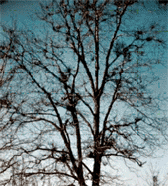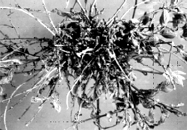Reports on Plant Diseases |
RPD No. 662 - Witches' Broom of Hackberry
|
July 1989
|
[ Symptoms ] [ Disease Cycle
] [ Control ]
|

Figure
1. Witches' brooms in a common hackberry tree.
|
Witches' broom is a very common disfiguring disease of hackberry.
It contributes to the undesirability of hackberry as a shade tree throughout
much of its range. Witches' broom is attributed to two agents acting together:
a powdery mildew fungus (Sphaerotheca phytoptophila) and a
minute, wormlike, eriophyid mite (Eriophyes celtis, synonym
Aceria snetsingeri) about 200 microns long. The two agents
are consistently and readily found attacking buds and shoots in "brooms,"
but neither has been tested for its ability to induce broom formation. Observations
suggest that mites may induce brooms and that the mildew fungus then invades
the deformed buds that result in the formation of the brooms.
Large common hackberry trees (Celtis occidentalis) may
have a few to hundreds of brooms without obvious loss of vigor (Figure
1). The brooms detract greatly from a tree's appearance, especially during
the dormant season. Trees growing in lawns, parks, and other open areas
are more frequently and severely affected than those in woodlands. The
severity of attack varies greatly among trees growing in close proximity
to one another, but the reasons for this variation are unknown.
|
Sugarberry (Celtis laevigata) is also affected but much less
frequently than the common hackberry. Chinese hackberry (Celtis sinensis)
and Jesso hackberry (C. jessoensis) are considered resistant. The Jesso hackberry
may not be hardy in central and northern Illinois.
SYMPTOMS
Each broom consists of numerous thin, short, stubby twigs that arise close
together, often at a conspicuous swelling or knot on a branch (Figure 2). Many
twigs in a broom die back during the dormant season after a year's growth. Buds
on the surviving twigs are very numerous, larger than normal, usually grayish,
and with looser scales than the buds on normal twigs.
Brooms first arrive from single infested and deformed buds, each of which produces
shoots with more infested buds. A loose broom may form on a vigorously growing
branch. Tight clusters of twigs commonly form along its axis. Tight brooms,
centered on knots, form on slowly growing branches which lose their apically
dominant habit.
DISEASE CYCLE
|
From spring to early summer the mycelium and chains of microscopic spores
(conidia) of the powdery mildew fungus, which appears as a fine white
powder, colonize the surface of young stems, petioles, buds, and sometimes
the lower leaf surface. Black specks (fungus fruiting bodies called cleistothecia)
soon form in the mycelial mat. Ascospores formed in an ascus within each
cleistothecium mature beginning in autumn. It is unknown whether the first
infections each year come from ascospores or mycelium within the buds.
Also unknown is whether conidia cause secondary infections.
Mites in all stages of development can be found throughout the year,
being most numerous in late summer. Up to 2,000 or more mites may colonize
a single bud. The mites overwinter beneath the bud scales and on the primordial
shoots within the buds. In the Midwest, female mites crawl to the new
buds and begin to lay eggs in May. New generations of mites develop throughout
the spring, summer, and fall.
|

Figure
2. Close-up of witches' broom showing a tight cluster of thin, short
twigs, some of which have already died (Purdue University photograph).
|
CONTROL
- Where feasible, purchase broom-free trees of resistant species such as
Celtis sinensis and C. jessoensis. Avoid planting
the common hackberry if the presence of witches' brooms is aesthetically unpleasant.
- Pruning out and burning or otherwise destroying witches' brooms is of limited
value.
- A lime-sulfur spray applied before the buds begin to open in early
spring is an old recommendation which is not usually practical.
Back to Top
For further information concerning
diseases of crucifers and other vegetables, contact Mohammad Babadoost, Extension
Specialist in Fruit and Vegetable Diseases, Department of Crop Sciences, University
of Illinois at Urbana-Champaign. University
of Illinois Extension provides equal opportunities in programs and employment.
|



